Create habitat for ruby-throated hummingbirds by adding native plants to your garden. These bright, fast-winged birds love tubular-shaped native flowers and a pesticide-free environment. Learn how to attract them with native plants that bloom throughout the season, providing a reliable source of nectar from spring through fall. From columbine and wild petunia to the stunning cardinal flower, this guide covers the best native plants for these beautiful pollinators. Discover tips on water sources, nesting options, and creating a garden that supports a healthy hummingbird habitat.
If you live east of the Rocky Mountains, the hummingbirds at your feeders are definitely ruby-throated hummingbirds (Archilochus colubris). The western U.S. has other species, but ruby-throateds are the only hummingbirds in all of eastern North America.
As is common in the bird world, it’s the males who have the more flashy plumage. They sport the bright red throat, called a gorget, while the females have a white throat. Both sexes of these magical birds have shimmery green feathers and beat their wings at a blistering 53 times per second. If you’ve ever seen them at a hummingbird feeder, you know these are common backyard visitors and they’ll hover and dart even close to humans.
Since they feed on nectar and insects, native plant gardens are perfect for attracting ruby-throated hummingbirds whether you have a feeder or not. The key is to grow tubular-shaped flowers because hummingbirds access nectar in those types of blooms.
“The tubular shape makes it harder for insects to eat from them, leaving these flowers full of nectar when hummingbirds stop by,” explains Emma Grieg, head of Project FeederWatch at the Cornell Lab of Ornithology. “There is evidence that hummingbirds have learned to prefer red flowers because they are tubular shaped and evolved to be pollinated by hummingbirds,” she says.
But these birds will also feed on flowers that aren’t red, so gardeners shouldn’t feel limited to only one color — nor should you add food coloring to any sugar water in a feeder. Natural nectar isn’t colored, and food coloring can be harmful to birds.
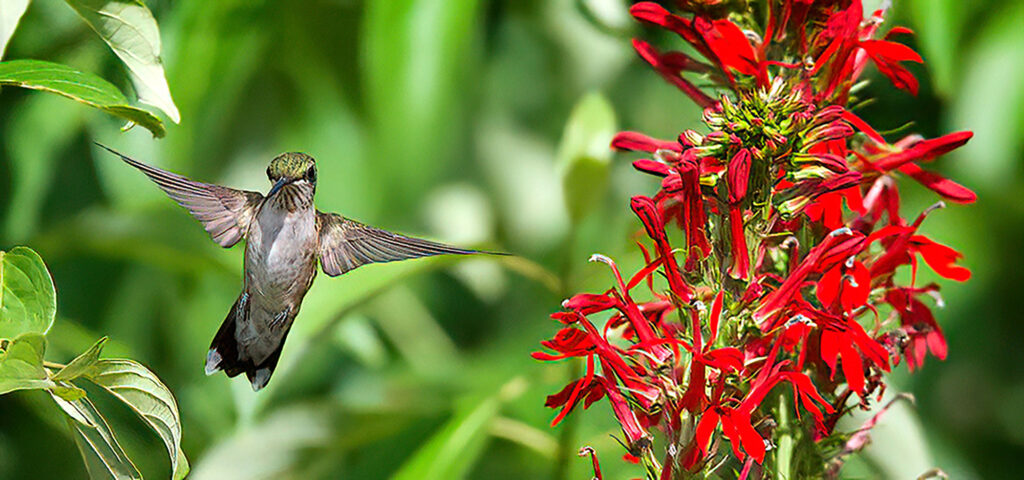
Native flowers for ruby-throated hummingbirds
Which natives are hummingbird favorites? Before you start planting, consider bloom time because it’s important to have flowers blooming in succession. “This is ideal so that there is always a nectar source available,” says Grieg. Ruby-throated hummingbirds arrive in the Midwest, Northeast and southern Canada around April.
For gardeners in these areas, columbine (Aquilegia canadensis) is an excellent spring bloomer to feed hummingbirds who just completed a grueling migration. Columbine’s flowers are sort of like an upside-down tube, but that doesn’t stop ruby-throated hummingbirds. These hardy plants grow in sun or shade and can handle a range of soil and moisture conditions. There are many great reasons to grow columbines, and their support of hummingbirds early in the season is just the icing on the cake.
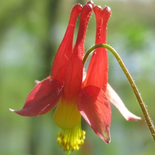
Red Columbine(Aquilegia canadensis)

Fringeleaf Wild Petunia(Ruellia humilis)
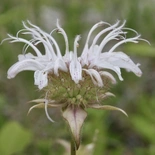
Eastern Beebalm(Monarda bradburiana)
As spring progresses to early summer, there are some purple natives that are perfect for hummingbirds: wild petunia (Ruellia humilis) and bee balm (Monarda fistulosa). Both begin blooming in early summer just as columbines are going to seed, and both have tubular shapes, albeit very different ones.
Wild petunia looks like its non-native namesake, and it’s a drought-tolerant, low-growing plant that’s just a bit taller than a groundcover. Ruby-throated hummingbirds will get low to access the purple flowers, and it makes a great companion plant for the taller, leggier bee balm, which grows in similar light and soil conditions. Bee balm’s blooms are tiny tubes with a distinctive, almost frizzy appearance. Both wild petunia and bee balm grow across the eastern U.S., making them perfect for attracting ruby-throated hummingbirds throughout their range.
But what about red flowers? In the running for the most beloved hummingbird plant is cardinal flower (Lobelia cardinalis), which blooms in mid- to late summer in soggy spots and rain gardens. If you have an area with consistent moisture, this plant will grow to be a hummingbird magnet. It’s especially attractive to these birds because of its shape and color, Grieg notes.
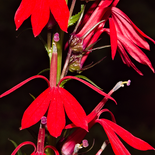
Cardinalflower(Lobelia cardinalis)
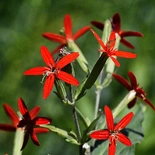
Royal Catchfly(Silene regia)
Cardinal flower isn’t the only red-colored native with the right flower shape for hummingbirds — the rare prairie native royal catchfly (Silene regia) is another summer bloomer that attracts ruby-throated hummingbirds. In fact, this plant’s sticky nectar traps insects (hence the common name, “catchfly”) that hummingbirds will also eat, making this a two-for-one food source. Royal catchfly grows in Florida and the Gulf Coast and into the Midwest, but zone 4 is the limit of its cold tolerance.
As summer turns to fall, ruby-throated hummingbirds start preparing for the long migration south to Mexico and Central America. This makes it vital to have nectar sources later in the season and well into September, when they begin migrating from northern areas. Two late-blooming natives to include in your garden are great blue lobelia (L. siphilitica) and obedient plant (Physostegia virginiana), both of which feature the distinctive tubular shape that hummingbirds need. They both also thrive in moist areas.
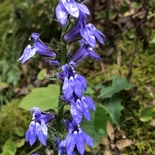
Great Blue Lobelia(Lobelia siphilitica)
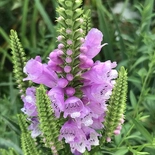
Obedient Plant(Physostegia virginiana)
Obedient plant belongs to the mint family, so it can spread aggressively in the right conditions. But if it’s planted with other native forbs and grasses to keep it in check, it won’t overrun your garden.
This full-season succession of natives will ensure that ruby-throated hummingbirds have nectar sources for the entire time that they’re north of their overwintering grounds, and it’ll keep your garden popping with colors and textures from spring to fall.
Other garden elements for hummingbirds
Nectar is crucial for ruby-throated hummingbirds, but it’s not the only thing they need. Like all birds, they require water, but remember these birds are different from typical backyard songbirds. “A shallow dish of water may attract hummingbirds, but they don’t often drink from standing water,” Grieg says. “Misters can attract them with little showers of water if a dish or tray doesn’t do the trick,” she advises.
A robust garden of native plants means a healthy supply of insects, which hummingbirds need to survive. Growing a diverse mix of native plants, not just tubular-shaped ones, ensures a thriving ecosystem where ruby-throated hummingbirds will gladly take up residence. “Make sure you don’t use pesticides if you want hummingbirds,” Grieg says, “because they need insects too.”
Nests are of course important, and ruby-throated hummingbirds build tiny nests on deciduous trees and occasionally pine trees. Having trees or large shrubs nearby will encourage the females to build a nest and raise their broods right near the helpful food sources you’re growing in your garden.
Ruby-throated hummingbirds are common backyard visitors, but that doesn’t mean they aren’t special. These birds will battle over food, hover near humans and windows, zip through garden beds, and perform important ecosystem functions like pollinating plants and controlling insect populations.
By growing a succession of native flowers that provide natural nectar sources, you can maintain steady visits from these fascinating birds, and enjoy a lively ecosystem right in your yard.
Additional source: Neil Diboll and Hilary Cox, “The Gardener’s Guide to Prairie Plants”, University of Chicago Press, 2023.

